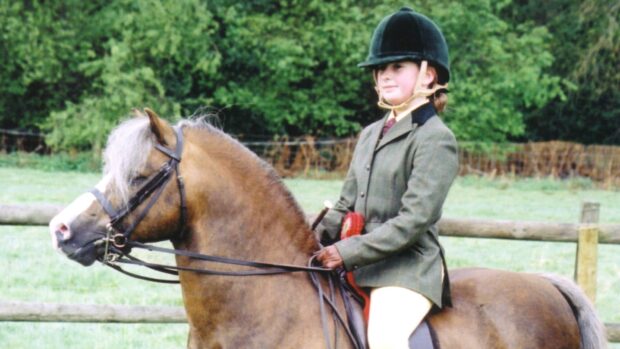The Welsh section B or Welsh pony cannot exceed 13.2hh (137.2cm). According to the Welsh Pony and Cob Association (WPCS): “The general description of ponies in section A of the stud book is applicable to those in Section B. But more particularly the section B pony shall be described as a riding pony, with quality, riding action, adequate bone and substance, hardiness and constitution and with pony character.” They can be described as the more refined and taller version of the section A. The B was developed by breeding mountain ponies with Hackney, Arab and Thoroughbred influences.
The section B was added to the stud book in 1931 and the WPCS provides the same breed standard as the section A with the above characteristics:
Head: Small, clean-cut, well set on and tapering to the muzzle
Ears: Well placed, small and pointed, well up on the head, proportionately close
Neck: Lengthy, well carried and moderately lean in the case of mares, but inclined to be cresty in the case of mature stallions
Shoulders: Long and sloping well back. Withers moderately fine, but not “knifey”. The humerus upright so that the foreleg is not set in under the body.
Forelegs: Set square and true, and not tied in at the elbows. Long, strong forearm, well developed knee, short flat bone below knee, pasterns of proportionate slope and length, feet well-shaped and round, hoofs dense.
Back and loins: Muscular, strong and well coupled
Hind quarters: Lengthy and fine. Not ragged or goose-rumped. Tail well set on and carried gaily.
Hind legs: Hocks to be large, flat and clean with points prominent, to turn neither inwards nor outwards. The hind legs not to be too bent. The hock not to be set behind a line from the point of the quarter to the fetlock joint. Pasterns of proportionate slope and length. Feet well-shaped, hooves dense.
Welsh section Bs could be described as the most versatile Welsh breed across the disciplines due to their athleticism, which enables them to stand up against quicker and finer non-native breeds. Many modern section Bs are also successful in plaited showing classes, standing at the top of show hunter pony lines ups at championship level.
They have straighter, more low and long striding movement than the A, C and D sections arguably with a more pointed toe which makes them suitable riding ponies. One of the most influential sires of the modern day Welsh section B breed was Tan-y-Bwlch Berwyn.
In the Horse Encyclopedia, Elwyn Hartley Edwards says that Berwyn was sired by a Barb stallion and his dam was the granddaughter of the section A stallion Dyoll Starlight.
Last year, Katy Marriott-Payne won the Olympia M&M ridden final at Olympia on the palomino Welsh section B gelding Cadlanvalley Sandpiper. Pure section Bs have also been seen on the BSJA circuit competing with much success. The stallion Rotherwood Signature is 128cm pure-bred who was SPSS showjumping pony champion in 2011 and 2012.
Section Bs are known for being great children’s rides and ponies which don’t exceed 12.2hh are often seen in M&M first ridden classes.
For all the latest equestrian news and reports, don’t miss Horse & Hound magazine, out every Thursday




